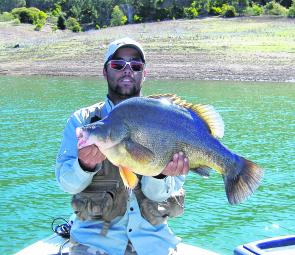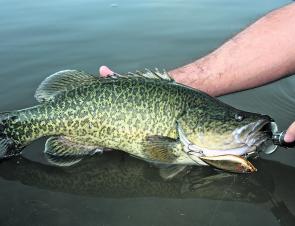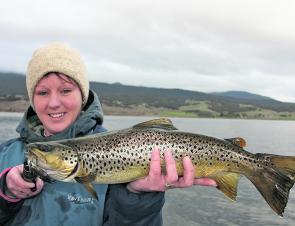Every so often a new lure or lure concept comes up and every keen fisho just has to get their hands on some. Not so long ago that lure was the lipless crankbait.
They are now regarded by many as the lures to turn to when casting for freshwater fish on both good and tough days.
In the June issue I wrote about how to cast with these versatile lures for river and impoundment fish, and now I’m going to explain why they are also invaluable when trolling for freshwater fish. Yes, trolling.
The greatest asset of these lipless lures is their versatility. They can be fished at any depth required, which is an awesome trait for any lure.
They are also made in a variety of sizes and weights and normally come with massive rattle chambers, which can attract fishes’ attention from many tens of metres away at times.
The main target species with these lures used to be bass and golden perch, but it is now acknowledged that they catch a whole host of freshwater species, from carp to Macquarie perch and everything in between.
Most people will tell you that you won’t get a much better casting lure than a lipless and I agree. But if you’re not in the right area you could cast for weeks and not land a fish. And if you simply don’t like to cast, you probably wouldn’t even own a lipless crankbait.
I love casting lures at edges and structure but I stumbled across the awesome abilities of the lipless on the troll when I was a little lazy one day. I simply chucked my lure out the back and started troll to another spot while having a bit of tucker. To my surprise, I didn’t get to eat much as I started hooking fish after fish.
That day we boated Murray cod, golden perch and redfin, proving that not only do lipless cranks work sensationally well on the troll, but pretty much every fish that swims will hit them.
I have since trolled lipless cranks with great success for over 10 years at Mulwala for Murray cod, Glenbawn Dam for bass, Windamere for golden perch and Blowering for goldens and redfin. Trout are also big suckers for a slow trolled lipless.
Any day is a good day to troll lipless crankbaits but those times when you just can’t seem to find the fish, no matter what you’re targeting, are probably the best.
Their very loud rattles can often switch on even the most shut-down fish and their greatest attribute on the cast is also their greatest on the troll – they can be worked at whatever depth the angler requires.
And when the fish are located, you can instantly cast back for more.
People often ask what speed is best to troll lipless cranks. I say it’s the same as when you’re running any other lure; you must let your lure dictate your speed by the way it is working.
It is no good going dead slow if your lure does not work at that speed. The best thing to do is to hold the lure in the water beside the boat, then work out the speed by watching your lure.
You don’t have to have the lure working like crazy. In fact, a lure that is just ticking over but still working generally catches more fish then a flat-out lure. Just don’t go so slow that your lure does not work at all.
There are a few different ways to get lipless cranks to swim at the depth you require.
For starters, you can change the angle of your rod in relation to the water or simply let more line out. These techniques alone can vary your lure’s running depth by a couple of metres or more.
Another simple way is to use lighter line, because it cuts through the water much easier and will get your lure deeper than a lure run on heavier line.
For example, a Jackall TN60 fished 30m behind the boat on 20lb braid will swim at 3m-4m, but if you were to use 4lb braid the same distance back your lure would be swimming somewhere around 6m-7m.
If you need your lure to swim only a metre or so deeper, you could just add extra weight to the lure with lead tape or copper wire around the trebles. Or if you own enough lipless cranks you could just put a heavier or lighter lipless lure on.
With so many different models and variations on the market, finding one that will troll at the specific depth you want is so much easier.
There are now floating models, silent models, plastic and rubber models, and their size and weight varieties are staggering, from tiny 30mm models which weigh only 2g up to 100mm-plus models of 26g or more.
With so many weights and sizes to choose from, these days I just change lures to achieve the running depth I require.
For more strikes from trout, redfin and Murray cod I slowly to moderately draw the rod forward 50cm-80cm almost constantly. A stop-start technique with your boat motor will also do the job, as long as that lure is rising and falling in the water column.
I also employ the stop-start technique when I have trolled over a big bottom-hugging fish several times without a strike. I stop the boat long enough to get the lure all the way to the bottom and in the fish’s face, then resume trolling and using the lift-and-draw technique.
Most of the strikes occur as the lure rises back up off the bottom as though it’s trying to flee.
When trolling for golden perch and bass, I’ve found the best results come by letting the lure do a slow, steady wobble rather than a rising and falling pattern.
It is important to keep a close eye on your sounder so you know exactly what depth you’re in at all times. More importantly, you can see exactly what depth the fish are holding at.
Colour selection varies from day to day and dam to dam, so experiment with colours until you find what works best on the day. In general, natural colours with white, gold and silver or black, red and purple are the more consistent fish-takers.
There is an ever-growing range of new lipless lures, yet there is a whole host of fishos who have not yet realised their potential as freshwater trolling tools. Don’t miss out!
And I wonder how some of the new highly-tuned metal blades would go on the troll?
Facts
TACKLE
Gear depends on your target species and the type of environment you are fishing. Anything from an ultra-light spin outfit with smaller lures for trout, redfin or bass up to a heavy baitcaster with bigger lures for golden perch, Murray cod and even barramundi will do the job.
Remember, finer lines get the lure down deeper.
Facts
SNAGS
Most lipless crankbaits are prone to snagging and if you’re fishing a heavily-timbered dam or river, you will get your fair share of snags. A good way of limiting your snag rate is to cut the down-pointing hook off the front treble (be sure you cut the right one). You can do it to both trebles if you really want for far fewer snags but I’ve found just taking that front one off is enough to reduce snags significantly without necessarily reducing your hook-up rate.
Alternatively, single lure hooks or assist hooks that swing free behind the lure can also reduce snag rates significantly.

To reduce the number of snags, try removing the down-facing hook off the front treble, but be sure to cut the right one. The hang-ups reduce but the hook-up rate stays much the same.

There aren’t too many species that won’t smash a slowly trolled lipless crankbait. Even carp get in on the action.

This thumping 652mm Blowering Dam golden perch hit a slow-trolled lipless in the shallows in the background.

Murray cod regularly hit trolled lipless cranks, especially on a stop-start or slow dragging technique.

This trout was caught in the dead of winter on a 50mm lipless crankbait. The size and running depth of this lure was well suited to the trout and the depth that they were holding.




